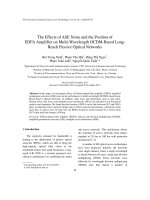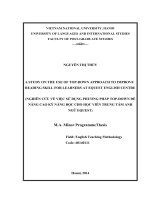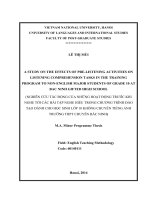THE EFFECTS OF READING ENGLISH NOVELS ON THE READING SKILL OF ENGLISH DEPARTMENT SOPHISTERS, THUONGMAI UNIVERSITY
Bạn đang xem bản rút gọn của tài liệu. Xem và tải ngay bản đầy đủ của tài liệu tại đây (398.85 KB, 52 trang )
THUONGMAI UNIVERSITY
ENGLISH DEPARTMENT
------
GRADUATION PAPER
THE EFFECTS OF READING ENGLISH NOVELS ON THE
READING SKILL OF ENGLISH DEPARTMENT SOPHISTERS,
THUONGMAI UNIVERSITY
Supervisor: Han Thi Bich Ngoc, M.A
Student: Do Ha Mi
Class: K52N6
Student’s code: 16D170379
HA NOI - 2020
ABSTRACT
International integration has become more and more intensive than ever
through time, which requires a surge in development and advancement in science,
language, and culture. With English as the Language of International
Communication, people have been given various opportunities to succeed and
progress in work. In four basic skills, reading skill is very important to develop the
knowledge and other elements for English skill, especially speaking and writing
skill. Through the open and diverse sources of books and novels, the chances to
improve a reading skill is becoming more convenient than ever. Apprehending the
benefits through novel reading could result in the right solution to enhance and
solve the difficulties in the reading skill as well as creating motivation for students
to passively study. Therefore this study was to identify the effects of English novel
reading on the reading skill of Thuongmai University English Department
sophisters. The study was conducted by tools of survey questionnaires. The
participant was asked to completed the survey related to reading comprehension
Hanoi - 2020
skills, which revealed the second-year English major attitudes towards reading
English novels, some obstacles they’re facing, and solutions for their reading skill.
Through the research, it is hoped that the learners will find the excitement as well as
the cons in reading English novels, so that they could have the right application in
improving reading as well as the motivation to keep reading as a conventional habit.
HÀ NỘI - 2016
1
ACKNOWLEDGMENT
The success and outcome of this graduation paper required a lot of guidance
and assistance from many people and I am extremely privileged to have got this all
along with the completion of my project. All that I have done is only due to such
supervision and assistance and I would not forget to thank them.
First of all, I wish to express my deepest gratitude to my supervisor – Ms.Han
Thi Bich Ngoc, M.A, the English teacher of the English Department, who has
always been willing to give me valuable advice and suggestions so that I can
complete successfully this study.
I also would like to take this opportunity to show my sincere thanks to all my
teachers in the English Department at Thuongmai University, who have handed me
basic knowledge to complete this study.
I am so thankful to students of K53N at the English Department for their
whole – heart participation in the study.
I would like to acknowledge my thanks to all the authors of the books,
magazines, and the other materials listed in the reference part for their ideas that
have been reflected and developed in the study.
I am equally indebted to my classmates for their suggestions and
encouragement in the process of my study.
Last but not least, my particular thanks are given to my parents for their
encouragement and support which played an important role in my graduation paper.
2
TABLE OF CONTENT
ABSTRACT..............................................................................................................i
ACKNOWLEDGMENT.........................................................................................ii
TABLE OF CONTENT.........................................................................................iii
LIST OF ABBREVIATIONS..................................................................................v
LIST OF TABLES AND FIGURES......................................................................vi
CHAPTER ONE: OVERVIEW OF THE STUDY...............................................1
1.1. Rationale...........................................................................................................1
1.2. Previous study...................................................................................................2
1.3. Aims of the study..............................................................................................3
1.4 . Research subject..............................................................................................4
1.5. Scope of the study.............................................................................................4
1.6. Research methodology......................................................................................4
1.7. Organization of the study.................................................................................5
CHAPTER TWO: LITERATURE REVIEW.......................................................6
2.1. Overview of Reading skill................................................................................6
2.1.1. Definition of Reading....................................................................................6
2.1.2. Definition of the Reading skill......................................................................7
2.1.3. The process of Reading skill.........................................................................8
2.1.4. Reading comprehension...............................................................................9
2.1.5. Kinds of Reading.........................................................................................10
2.2. Overview of English novel............................................................................12
2.2.1. Definition......................................................................................................12
2.2.2. Effects of reading English novel on reading skill......................................12
CHAPTER THREE: RESEARCH FINDINGS..................................................16
3.1. Participant of the research.............................................................................16
3.2. Data collection instruments...........................................................................16
3.2.1. The survey questionnaire............................................................................16
3.3.2. The interview...............................................................................................16
3.3. Procedures of data collection.........................................................................17
3.4. Procedures of data analysis............................................................................18
3
3.4.1 Students’ current English learning situation..............................................18
3.4.2. Students’ perspective in reading skill and evaluation of their reading
level......................................................................................................................... 19
3.4.3. Students’ habit of reading English novel and reading frequency.............23
3.4.4 Students’ opinion and attitude towards English novel...............................24
3.4.5. The obstacles in reading English novel......................................................26
3.4.6. Students’ frequency in self-reading activities............................................27
3.4.7. Activities for improving reading English novel.........................................28
3.4.8. Results from the interview..........................................................................30
CHAPTER FOUR: RECOMMENDATIONS AND SUGGESTIONS..............32
4.1. Summary of the effects of reading English novel.........................................32
4.1.1. English novel on the interest and concentration of the students..............32
4.1.2. English novel on the vocabulary of the students.......................................32
4.1.3. English novel on the knowledge of the student..........................................32
4.2. Suggestion to improve English novel reading experience effectively..........33
4.2.1. Highlight – look up and note down............................................................33
4.2.2. Re-read and search for the information in the novel................................33
4.2.3. Listen to music while reading.....................................................................33
4.2.4. Read as much as possible............................................................................34
4.3. Limitations of the study.................................................................................34
4.4. Recommendation for further studies............................................................35
CONCLUSION......................................................................................................37
REFERENCES......................................................................................................38
APPENDICES..........................................................................................................I
4
LIST OF ABBREVIATIONS
TMU: Thuongmai University
ED: English Department
ESL: English as a Second Language
PISA: The Program for International Student Assessment
OECD: Organization for Economic Co-operation and Development
ERS: English Reading Skill
LIST OF TABLES AND FIGURES
5
Figure 1. Definition of reading (David Nunan. Practical English Language
Teaching. 2003. p. 72)..............................................................................................6
Chart 1. Length of time in studying English.........................................................19
Chart 2. Opinions in obtain and achieve ERS.......................................................20
Chart 3. Students comprehension ability through different types of reading
materials.................................................................................................................21
Table 1. Students comprehension ability through different types of reading
materials (%)..........................................................................................................22
Chart 4. Student’s reading habit............................................................................23
Chart 5. Frequency of students’ English novel reading........................................24
Chart 6. Students’ opinion towards English novel................................................25
Table 2. Students’ frequency in encountering novel reading problems................26
Chart 7. Student’s frequency of the activities in reading......................................27
Table 3.Students’ opinion in the activities while reading......................................29
6
CHAPTER ONE: OVERVIEW OF THE STUDY
1.1. Rationale
In daily life, people have many ways to study and improve our English skills,
through music, movies, and the Internet or with the people they have interacted with
and so on. However, it is believed that people tend to be attracted and remember
things longer through stories. It has been told since the beginning of time and has
been the main form of education since then. Therefore, making reading a habit is
very important to develop reading skills and one of the great sources that cannot be
forgotten is the English novel.
The author would like to present the thesis title “The effects of English novel
reading on the reading skill of the Thuongmai University English Department
sophomores” for several reasons:
Primarily, reading skill has been considered as the most significant skill based
on the confirmation of employers in 12 industries. Due to international integration,
most of the large company has multilateral, and bilateral cooperation with
foreigners. The frequency and the amount of English used in international
publications, contracts and instruction have become immense. Because of that
characteristic, reading skill is vital. The author wanted to put research to help
students acknowledge the importance of reading skills in practical.
Secondly, reading books and novels is a great way to study. Besides textbooks
and theories, students could have more options and variety of sources of the English
novel. It is a very sophisticated subject which teaches among other things, not only
helps students to have an external perspective but also teaches them valuable
lessons through allegories and metaphors. Students could familiarize themselves
with the jargon and new words through reading the English novel also.
Finally yet importantly, after 4 years studying in ED at TMU, the author
realized many second-year students in English major have difficulties in reading
English. They can read with some degree of proficiency but are still unable to
understand what they are reading. Many of them haven’t fully exploited the
materials in reading books and its advantages to improve their skill as well as their
1
knowledge. They are eager with reading long texts and books, which could be the
problem with ineffective and wrong ways of reading and choosing novel which is
not suitable for their level.
With the main motive to help the second year student realize the benefits, have
more motivation to explore the world of English novel and methods to improve
their reading habit actively, the author would like to conduct this study to identify
the factors and effects of reading English novel on the reading skill.
1.2. Previous study
On account of English as a Second Language (ESL), there have been some
studies about the importance of reading skills as well as the significance of English
novel, or English books in general.
According to Cencage (2019), through a survey poll, there are 69% of
employers are looking to hire people with “soft” skills, like the ability to
communicate effectively. Reading books is the best way to increase peoples’
exposure to new words, learned in context.
Researchers from the National Institutes of Health have found that students
who read books regularly, beginning at a young age, gradually develop large
vocabularies. And vocabulary size can influence many areas of your life, from
scores on standardized tests to college admissions and job opportunities.
A study on reading literary fiction in both print and electronic media involving
young Swedish adults (Nilsson, 2016) found that reading fiction is beneficial to
readers. In particular, the participants in the Nilsson study believed that reading
fiction was important for self-awareness and personal development, including
language skills in general.
“There has been rather less research on how reading different text types—for
instance, the frequency with which young people read fiction books compared to
non‐fiction
books—is
associated
with
young
people's
reading
skills”
(McGeown et al., 2015; Sullivan, 2015).
The recent work of Wolf (2018) raises the issue that ‘deep reading’ (such as
being very engaged with a fiction book) has started to decline in the digital era. Yet
she claims that such deep reading is likely to be linked to young people's ability to
2
concentrate for prolonged periods of time and their ability to maintain focus. Hence,
a ‘fiction effect’ might well emerge because it requires young people to concentrate
and read deeply, encouraging meaningful thought and reflection upon what they are
reading, rather than just superficially gathering information by skimming through
shorter texts
There is some evidence that stories have a particular role in enhancing social
cognition (Mar, 2018) and from this point of view fiction texts may be particularly
effective in engaging young readers in developing ‘a clear, complete, and
integrated representation of the meaning of a text’ (Oakhill et al., 2015).
Novels can also play a part in developing young people's social networks as
‘good reads’ are shared amongst friendship groups (Moss, 2007). The discussion
above clearly illustrates that there are strong theoretical reasons why one would
suspect that reading certain types of text may be more important for the
development of young people's reading skills than others.
Besides other reading materials (magazines, newspapers,..), the novel is a
splendid source for students who study English as a second language in a nonnative setting and wanted to improve their reading skills. In general, it is vital to
conduct a research on “The effects of reading English novel on the reading skill of
English Department sophisters, Thuongmai University”.
1.3. Aims of the study
The purpose of the study is to identify:
The current reading English novel frequency of second-year English major
students.
The reading comprehension level of students in reading the novel.
The benefits that student gained through novel reading and the difficulties
faced with reading English novel
To achieve this purpose, the author tends to seek answers to these questions:
What is the real situation of reading English novel for the second year
English major students at TMU?
What problems do students face in reading and understanding the novel
and content to improve?
What methods to improve effective reading and reading comprehension?
3
1.4 . Research subject
The research subject are the second-year English major students of ED in
TMU. The study is mainly focused on the effects of reading English novels on the
reading skill with the participation of 54 sophomores who are learning business
English.
1.5. Scope of the study
The study is about the influences of English novel on the reading skill of
sophomores at ED, TMU. Due to the lack of time, limited knowledge and the
shortage of reference materials, this study cannot cover the whole issues of reading
skills and the significance of the English novel.
Therefore, it’ll only focused on finding the common obstacles in reading that
students encountered and the prominent effects they have in the process of reading
English novels. Furthermore, the study only covers a limited amount of subjects
which are 54 students of K53 at ED, TMU.
1.6. Research methodology
This study applied both qualitative and quantitative methods
Initially, the quantitative method was conducted by a design of a questionnaire
with the participation of 50 sophomores in ED, TMU to understand the reality and
impact of English novel of the K53N students in their reading skill along with the
solutions for better approaching to the English novel.
Survey questionnaire for 50 English major undergraduate students contains 9
questions to seek information for the three research question which involved in four
sections: (1) general information background, (2) English novel reading frequency
and reading skill evaluation, (3) challenges in reading English novel, (4) suggestion
to improve reading skill and further exploitation on foreign literature. After the
result is gained, tables and charts were used to conduct the data collection from the
survey questionnaire. This will allow the researcher to have better insights from the
data and analyze it easily.
Other than that, the qualitative method was performed through an online
interview. This was conducted with the participation of 4 students in 2 classes of
K53 in ED at TMU. With their acceptance and collaboration, the ideas and other
4
perspectives about the effects of reading English novels will be clearer as well as
the difficulties and suggestion gave out.
1.7. Organization of the study
This study consists of four main chapters, organized as below:
Chapter One is the Overview of the study. This chapter includes the rationale,
previous studies, the purpose of the study, research subjects, scope of the study,
research methodology, and organization of the study. It summarizes the reason for
choosing this study and the methods for the completion of the study.
Chapter Two includes the introduction to Literature Review, with the intention
to give out some theoretical knowledge related to English novel, reading skill, and
the problems that students have encountered, along with the review of relevant
researches.
Chapter Three offers Research Findings. This chapter contains the selection of
participants, data collection instruments, and procedures of data collection, data
analysis from survey questionnaire and interview, as well as the result of the
findings.
Chapter Four shows the Recommendations and Suggestions. It discussed the
summary of findings and the suggestions to help students have a better method to
effectively read an English novel. In addition to that, this chapter also includes the
limitations and recommendations for further study.
5
CHAPTER TWO: LITERATURE REVIEW
2.1. Overview of Reading skill
2.1.1. Definition of Reading
“Reading is one of the most effective ways of foreign language learning.
Reading simply is the interpretation of a written message” Walter R. Hill (1979,
p.4) briefly defines reading as what the reader does to get the meaning he needs
from contextual resources.
“Reading is a fluent process of readers combining information from a text and
their own background knowledge to build meaning and the goal of reading is
comprehension” (Nunan, 2003, p.68).
“The ability to read requires that the reader draw information from a text and
combine it with information and expectations that the reader already has” (Grabe,
Stoller, 2001, p.187).
Alderson J.C. (2000) stated that reading is built from two components: word
recognition and comprehension. These two components gained through reading will
foster learners’ language competence.
Krashen and Terrell (1989, p.131) point out that reading enables learners to
comprehend better which is an important factor that can develop language
competence.
Figure 1. Definition of reading (David Nunan. Practical English Language
Teaching. 2003. p. 72)
6
Hedge (2003) writes the goals of learners’ in a reading process as:
The ability to read a wide range of texts in English.
Building a knowledge of language which will facilitate reading ability
Building schematic knowledge
The ability to adapt the reading style according to reading purpose
(skimming, scanning)
Developing an awareness of the structure of written texts in English
Taking a critical stance to the contexts of the texts Reading will add to
learners’ conversational performance.
Reading will help learners to decipher new words that they need for
conversations. Through reading, language learners will have vocabulary knowledge
which will facilitate their speaking performance and their usage of structure in the
target language will develop. These components which are required through reading
are all necessary for developing speaking skills.
Similarly, Williams (1984, p.13) suggests some reasons why language learners
should read in a foreign language:
Learners can have further practice in the language that they have learnt,
Learners can practice language in order to reuse it in other skills such as
speaking
Learners can learn how to get benefit from the texts to extract the
information they need
Learners can find enjoyment or interest through reading.
2.1.2. Definition of the Reading skill
Reading skill refers to the ability to understand written text. It is advisable to
develop this skill at the early age of schooling. When students comprehend or
understand written text, and combine their understanding with prior knowledge,
they can to perform the following three reading-comprehension skills.
Identify simple facts presented in written text (literal comprehension)
Make judgments about the written text’s content (evaluative
comprehension)
Connect the text to other written passages and situations (inferential
comprehension)
7
According to F. B. Davies (July 1968), reading skills involve: identifying
word meaning, drawing inferences, identifying writer’s technique, recognizing
mood of passage, finding answers to questions.
J. Munby (1978) claimed that reading skill can also include: recognizing the
script of language; deducing the meaning, use of unfamiliar lexical items;
understanding explicitly and non-explicitly
stated
information, meaning,
communicative value of sentences, relations within the sentences and between parts
of text through lexical cohesion devices; recognizing indicators and main point
of information in discourse; distinguishing main idea from supporting detail;
selective extraction
of relevant points from
the text; basic
reference skills;
skimming, scanning, transcoding information from diagrams/charts.
E. Lunzer, M. Waite, and T. Dolan (1979) assumed that reading skills are as
follows: word meaning in context, literal comprehension, drawing inferences,
interpretation of metaphor, finding main ideas, forming judgments.
“Reading skills also involve: automatic recognition skills, vocabulary and
structural
knowledge, knowledge, formal discourse
structure content/world
background knowledge, synthesis and evaluation skills/strategies, metacognitive
knowledge and skills monitoring.” (W. Grabe- pp. 375-406, Autumn 1991)
“Grabe’s taxonomy uses very general categories, equivalent to knowledge
areas. If reading itself is a skill, it must be possible to break this down into
different levels of component skills categories.” (W.Grabe- pp. 375-406, Autumn
1991)
2.1.3. The process of Reading skill
The following types of reading are important to discuss : search reading locating information on predetermined topics; skimming - reading for gist;
scanning - reading selectively to achieve very specific reading goals; careful
reading - reader attempts to handle majority of information in the text and to
build up a macrostructure.
A. H. Urquhart (1998) stated, the reader
may choose kind of
reading
according to the perceived demands of the learning task. Adopting a range of
reading styles during pre-reading (predicting, word association, discussions, text
8
surveys), while-reading (a list of questions, scanning and skimming activities,
working
out
the meaning
of
unfamiliar words, pattern study
guides,
summarizing, clarifying, questioning, predicting, etc.) and post-reading activities
(review of the content, work on grammar, vocabulary in context or word roots,
discourse features, consolidation of what has been read by relating the new
information to the students’ knowledge, interests, and opinions through a writing
assignment, discussions, debates, role-plays, project work) in second language
classroom is necessary for successful interaction with the authentic texts.
2.1.4. Reading comprehension
Reading comprehension is the process of simultaneously constructing and
extracting meaning through interaction and engagement with print. According to
RAND Reading Study Group (2002), comprehension is the process of eliciting and
making meaning through interaction and involvement with written language.
McNamara and Magliano (2009) emphasized that this process is a task of both
reader and text factors that happen within a larger social context. Duke (2003)
stated that “comprehension is a process in which readers make meaning by
interacting with text through the combination of prior knowledge and previous
experience, information in the text, and the views of readers related to the text.”
Kintsch (1998) and van Dijk and Kintsch (1983) defined reading
comprehension as the process of creating meaning from text. “The purpose is to get
an understanding of the text rather than to acquire meaning from individual words
or sentences”. The outcome of reading comprehension is the mental representation
of a text meaning that is combined with the readers’ previous knowledge. This is
called a mental model (Johnson-Laird, 1983) or a situation model (Kintsch, 1998).
This model defines what has been learned (RAND Reading and Study Group,
2002).
Keenan, Betjemann, and Olson (2008) expressed that “reading comprehension
needs the successful expansion and arrangement of a lot of lower-and higher-level
processes and skills.” Accordingly, there are many sources for possible
comprehension break and these sources are different based on the skill levels and
age of readers.
9
Based on the book by Timothy C. Papadopoulos (2015) “reading
comprehension is essential for successful functioning in our society. In virtually all
instances, the goal of reading is to identify the meaning or message of the text at
hand”.
“Reading is not merely a process of exact identification of letters, words,
and ultimately sentences leading to comprehension built from letter to word to
phrase to sentence” (K. S. Goodman, pp. 126-135, May 1967). But in other
perspective, it can be understood in different way, not just to comprehend it with
full meaning or ideas .
According to D. E. Rumelhart (1980, pp. 33-58) and D. E. Rumelhart (1997,
pp. 99-135)
“readers
make
use of their existing background
knowledge
(schemata) to make predictions about what is coming next in the text and
about how some new, unfamiliar piece of information relates to what is already
known.”
“It is clear that basic decoding processes are important for comprehension
and are used by readers in interaction with the more complex processes of
meaning generation” (D. Eskey, 1987).
Through the definitions above we can see that reading comprehension is to get
the full sense of the content and it’s idea when we read.
2.1.5. Kinds of Reading
Extensive Reading
There are different definitions for extensive reading. Hedge (2003) described
it as skimming and scanning activities while Hafiz and Tudor (1989 as cited in
Alyousef 2005) expressed that “exposing learners to large quantities of meaningful
and fascinating materials and activities will have a significant impact on the
learners”.
Hedge (2003) declared that extensive reading differs based on learner
motivation and school resources. A highly motivated and well-trained teacher can
certainly select appropriate materials and activities for their own learners.
Hedge (2003) stressed that because extensive reading assists in expanding
learners’ reading skill, it should be incorporated into the EFL/ESL program
10
provided that the chosen texts are valid and classified. In addition, extensive reading
helps learners to gain their independency through reading either in class or at home.
According to Carrell and Eisterhold (1983 as cited in Alyousef 2005),
extensive reading activities can be beneficial in aiding learners to become selfdirected individuals who are searching for meaning provided that they are based on
student-selected texts that learners will be interested in what they are reading. The
process of choosing reading texts will be done according to content, level of
difficulty, and length.
Hedge (2003) mentioned the benefits of extensive reading as follows: Students
can make their language proficiency, advance in their reading skill, become more
independent in their learning, learn cultural knowledge, and expand confidence and
incentive to continue their own learning.
Intensive Reading
In this type of reading, learners read a page to find the meaning and to be
familiar with the strategies of writing. Through this reading, students can get
fundamental practice in performing these strategies based on a series of materials.
These strategies can be either text-related or learner-related. The first involves
recognition of text organization and the second involves strategies such as
linguistic, schematic, and metacognitive strategies (Hedge, 2003).
Yang, Dai, and Gao (2012) expressed that intensive reading is useful to
develop reading comprehension. According to Waring (1997), intensive reading is
very important for learning vocabulary and understanding how text is formed. Stahl
(2003) found that there is relationship between intensive reading activities and
language proficiency.
According to Paran (2003), teachers need intensive reading to increase the
three phases of learning called pre, during, and post-reading for better language
readiness, retention, and activation strategies.
Pollar, Durodo, Gonzalez, Simmons, Kwok, Taylor, Davis, and Simmons
(2011) said that intensive reading is considered as a significant instrument for
improving reading comprehension.
11
2.2. Overview of English novel
2.2.1. Definition
Sommerville, C.J (1996) stated that a novel is a long fictional prose narrative.
In English, the term emerged from the Romance languages in the late 15th century,
with the meaning of "news"; it came to indicate something new, without a
distinction between fact or fiction. The romance is a closely related long prose
narrative.
Walter Scott (1992) defined it as "a fictitious narrative in prose or verse; the
interest of which turns upon marvelous and uncommon incidents", whereas in the
novel "the events are accommodated to the ordinary train of human events and the
modern state of society."
As stated through Doody (1996) other European languages do not distinguish
between romance and novel: "a novel is le roman, der Roman, il romanzo",
indicates the proximity of the forms. In general, novels are type of fiction book
which consist of elements such as plot, themes, setting and characters. They vary in
many different genres typically such as mystery, horror to romance... Each of them
has its own significant, with a good plot and story flow, people’s attention usually
being caught up.
2.2.2. Effects of reading English novel on reading skill
2.2.2.1. English novel on the interest and concentration of the students
There was a quote once said by Garrison Keillor: “A book is a gift you can
open again and again”, it is really true. From author’s personal perspective and
opinion, nothing is better to improve our reading skill but not feeling too
overwhelmed with the language itself is by novels.
“The pleasure experienced from reading literary fiction is generally very
positive” (Oriogu, 2015; Pino and Mazza, 2016; Yildirim and Soylemez, 2018).
Each novel is a different stories, it could be about a person, a portrait of scenery or
characters throughout the whole book in the eyes of the writer. Novels not only
increases our ability to be empathetic towards others but also enhance our
attentiveness and the reading skill.
12
The novel attracts our interest and concentration to follow the plot and let our
mind catch the gist of that content. And so, we tend to focus more on the words, the
structure of the sentences and the usage of the words as well. Previous work has
highlighted the importance of young people being engaged in the texts that they are
reading (Arizpe & Cliff‐Hodges, 2018), which is likely to be particularly important
for the development of reading skills. Certain types of text (e.g. fiction, novel) may
be more engaging to readers than others (e.g. magazines) and hence potentially have
more influence upon young people's academic outcomes.
Additionally, when the curiosity to find out more, expectation for what comes
next when reading a novel accumulates, students reading habit will gradually
increases, this is one of the effects that the novel gives us.
2.2.2.2. English novel on the vocabulary of the students
By further reading and exposing to the new words, idioms, the student would
most likely be able to understand the whole context of the paragraphs and
sentences. Because print material generally contains many more low frequency
words than does spoken language (Cunningham, 2005), “reading text can provide
key opportunities for advancement in vocabulary development”
Martinich (2001) stated that the language used in narrative fiction is no less
inferior or less linguistic than the language used in narrative nonfiction. The
principles of conversation still apply to both nonfictional and fictional contexts.
“Conversation is meant to express ideas in order to satisfy goals, which is no less
evident in fiction”, according to Martinich’s theory. Even though novel includes
unrealistic factors but some of them
Nagy, Herman & Anderson (1985) and Sternberg (1987) stated “There is
empirical evidence that, for older children and adults, much learning of new words
occurs through exposure to written texts”
Sanacore (1994, p.604) has given opinion that “encouraging learners to read
will lead them guessing the meanings of words, phrases from the context, and the
more they read the more they will understand the meanings of sentences and
concepts”. And an ongoing reading habit will enable learners understand a text
13
easily, even they do not know meanings of some words in the text. Reading
extensively will enhance their comprehension skill.
“To complete a fiction book simply takes more time. To get from beginning to
end requires more sustained commitment than dipping in and out of a newspaper or
magazine” (Moss & McDonald, 2004). Reading novel makes us
As stated by Bright and McGregor, their opinion that reading is ‘the most
pleasant route to command of the language’, because it is via reading ‘the student is
most likely to find words used memorably with force and point.’(1970, p.53).
Reading text can provide key opportunities for advancement in vocabulary
development. We predict that word learning through reading will affect vocabulary
as measured on both oral and written tasks because words learned through reading
text will be at least partially available to the individual for both written and oral
language use (Nelson, Michal, & Perfetti, 2005).
A broad and deep vocabulary knowledge makes learners precise and articulate.
Through reading learners see how the new words connect to other words. “The
more reading you will do, the more you will increase your exposure to vocabulary
that doesn’t usually make its way into the spoken language” (Cunningham, 1998)
2.2.2.3. English novel on the knowledge of the students
“The cognitive demands that extended narrative texts make on their readers,
through exposure to new vocabulary, different syntactic structures and deeper
lexico-semantic networks, may in themselves encourage the development of new
competencies and increase reader capacity to handle greater textual complexity”
(Krashen, 2004; Oakhill et al., 2015; Suk, 2016; Westbrook et al., 2018).
John Jerrim, Gemma Moss (2018) using data from the 2009 round of the
Program for International Student Assessment (PISA) study to investigate how the
frequency with which 15‐year‐olds read five different text types (non‐fiction books,
fiction books, newspapers, magazines and comics) is linked to their reading
achievement. This study found out strong evidence that frequently reading fiction
books is associated with higher PISA reading scores and that this relationship is
found within almost every Organization for Economic Co-operation and
Development (OECD) country. Young people who read this type of text frequently
14
have significantly stronger reading skills than their peers who do not. In contrast,
the same does not hold true for the four other text type, it comes to the conclusion
that encouraging young people to read fiction may be particularly beneficial for
their reading skill.
CHAPTER THREE: RESEARCH FINDINGS
3.1. Participant of the research
The study was carried out by 54 sophomores from K54N of TMU when they
were in the second semester of their academic year of 2019-2020. A majority of
them have learned English for 10 years (from primary school to high school
throughout the years) while others have less amount of time to interact with
English.
Despite the time length that they have studied, due to the low practical usage
of English and influences from the curriculum for high school students, many of
them are not very experienced in English.
In consequence of that, by the time they have enrolled in TMU, their English
proficiency was limited and they have to face up with many obstacles in studying
English and catch up with the lesson at classes.
3.2. Data collection instruments
The study has been conducted in both qualitative and quantitative methods to
avoid the possible limitations of using only a single approach. The data have been
collected by an online Google form questionnaires and online interviews through
video group calls.
3.2.1. The survey questionnaire
The online survey questionnaire consists of 9 questions, from basic
information about English proficiency of the participants and their opinions,
evaluation to suggestions about English novel and activities in reading it.
Consequently, if the strategy is effective or unproductive, it will be used to give the
conclusion for suggesting solutions to enhance their reading skill.
15
3.3.2. The interview
The interview includes three questions to get further aspects in reading
English novels in order to support the study. The first question is to find out the
reason why students choose to read English novels. Based on the situation, the
second question is given to get information about the challenges and difficulties that
students experienced. The final question is for students to give out solutions that
they have applied and identified whether it is effective or not.
The interview has the amount of time from ten to fifteen minutes.
In this survey, the researcher have used 3 questions for the interview:
1. Why do you choose to read an English novel?
2. Do you encounter any difficulties while reading and trying to understand
the content of the novel?
3. How do you solve that problem? Do you feel that it has any effects on
your reading skills?
3.3. Procedures of data collection
The survey was carried out from 1st to 12th April 2020.
In the beginning, the link of the survey questionnaire was sent to 50 students
through a designed Google form. The data collection of the study is based on the
point of view from students in the business English major at TMU about the effects
of English novel reading.
Furthermore, 4 other students were also invited to participate in the interview
through a video call. The interview finished when the participant has given enough
opinion and answers or doesn’t have any further recommendations. During the
interview, the content of the whole process has been re-noted to the collected
information for the authenticity of the data.
This section explains the whole process of gathering information for the
statement problems. The steps are as follows:
The researcher first send the Google form links for students to fill in
For the interview, the researcher makes a video group call and interviewed
each of the participants about their perspective in reading English novels and
suggestions for better reading comprehension skills.
16
Finally, the data was collected both from the Google Excel and the note
obtained from the interview
The survey questionnaire has been designed as detail as possible in order to
give the participants a clearer vision and purpose of each question. For the interview
process, the participants are encouraged to give further ideas and a self-point of
view.
At last, the researcher collects the questionnaire and interview results for the
analysis process.
3.4. Procedures of data analysis
The data was collected through 2 different instruments including interviews
and questionnaires.
The quantitative data obtained from the survey questionnaires were converted
into percentage and showed in the form of charts and tables. Related questions of
the questionnaire, the interview, and responses were analyzed qualitatively.
Data analysis was performed through Excel which was known as one of the
most popular spreadsheet software that enables the calculation and synthesizes.
Therefore, the researcher chooses to use Excel to accomplish the data, formulas, and
functions into the worksheet.
After calculating automatically, it is necessary to format the worksheet and
embed pie charts and bar graphs to display the results. Subsequently, the charts and
the supporting data appeared to present clear percentages.
Additionally, Word was also employed as a common method to create a simple
table, the charts showed perfectly the uncomplicated data including information in
order to give the reader a better reading and understanding.
3.4.1 Students’ current English learning situation
From the first question which mentioned about personal information, a
majority of students have been learning English for more than 10 years, only a
minority of them have been learning English for 0-3 years. The answer for the
amount of time from 4-6 years and 7-10 years is in the average number.
17
0-3 years;
4-6 years; 6.00%
18.00%
7-10 years;
24.00%
More than 10 years
4-6 years
More than
10 years ;
52.00%
7-10 years
0-3 years
Chart 1. Length of time in studying English
Chart 1 shows the analysis for the duration of the English study. It can be seen
that in a total of 50 students, the number of answers that have been studying English
for more than 10 years took the highest percentage, about 52% with 26 students.
As the amount of studying time decreases, the percentage of students
gradually shrivel. The number of answers shows that the studying period from 7-10
years took 24% and from 4-6 years there is 18%. There is only a small number of
students answered that they have the studying duration from 0-3 years, which only
took 6% of the pie chart.
3.4.2. Students’ perspective in reading skill and evaluation of their reading
level
The next 2 questions (questions 2 and 3) revealed the students’ opinions
towards the level of difficulty in obtaining, improving proficient English reading
skills, and over against the different types of English reading materials.
First is the point of view in attaining a good comprehension skill, pie chart 2
illustrates the percentage of the difficulty level which the students choose.
From the pie chart, at 66%, it is estimated that almost half of the students
replies it is quite difficult to advance their reading skills. Additionally, the
percentage of students who think that it is hard to boost the skill is at the average
number, with 26%.
18
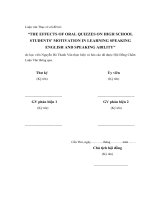
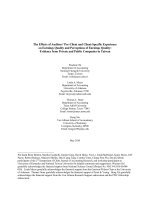
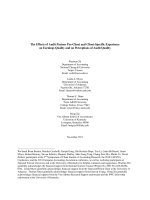
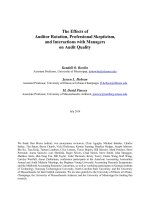
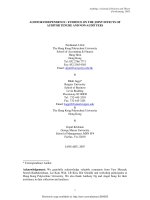
![daniels and booker - 2011 - the effects of audit firm rotation on perceived auditor independence and audit quality [mafr]](https://media.store123doc.com/images/document/2015_01/06/medium_sds1420548148.jpg)

